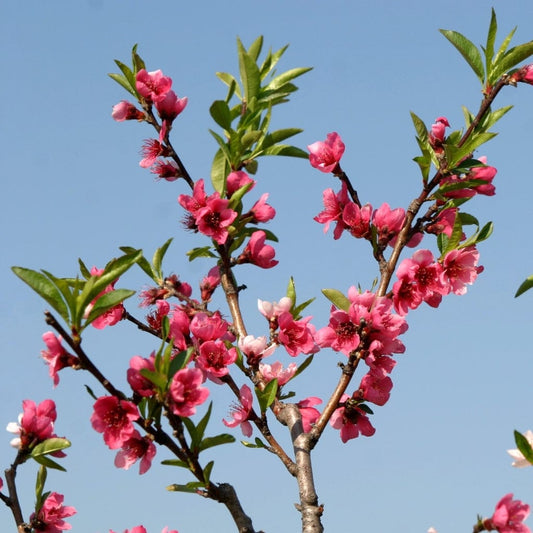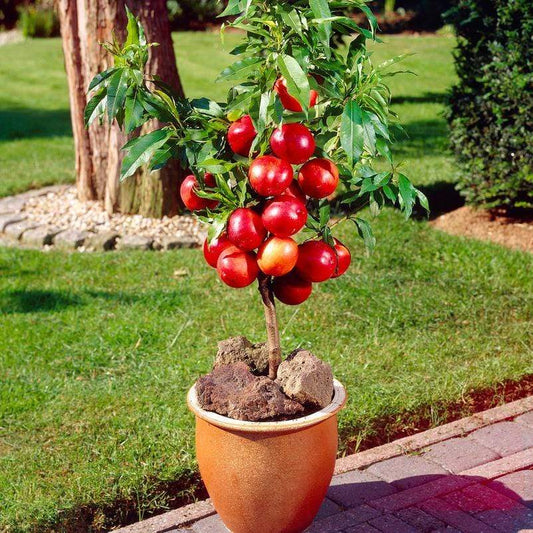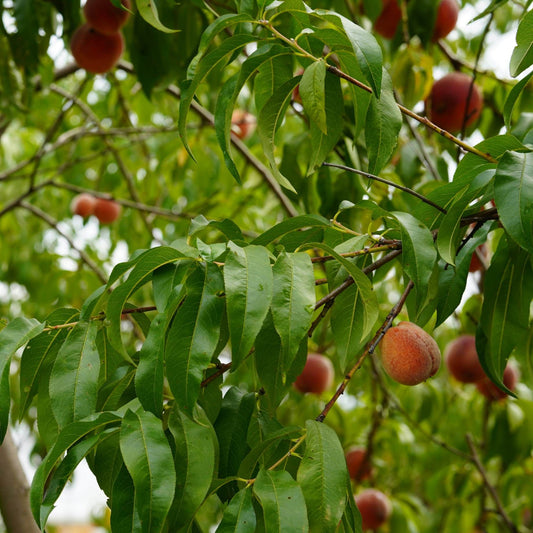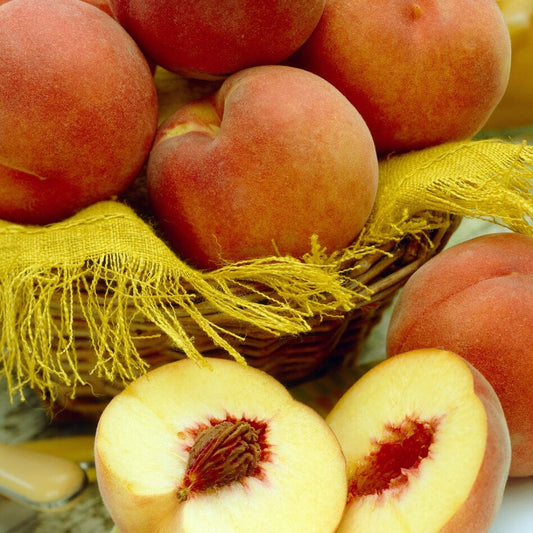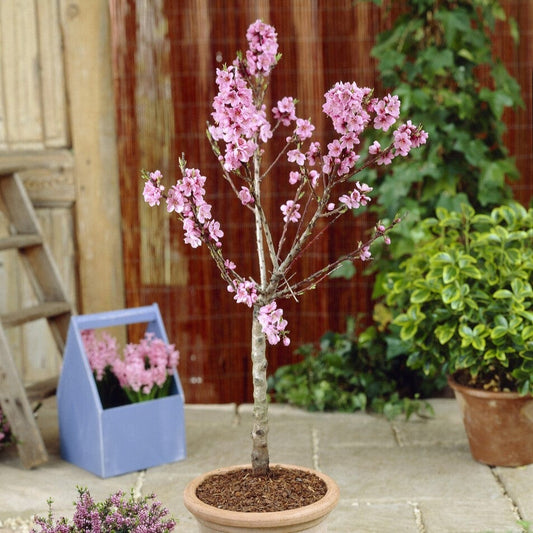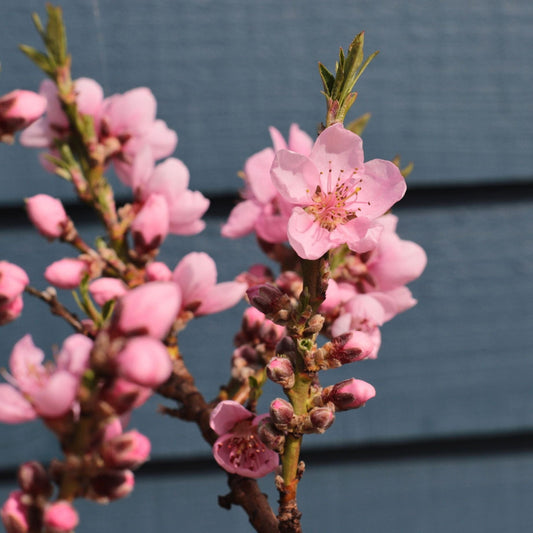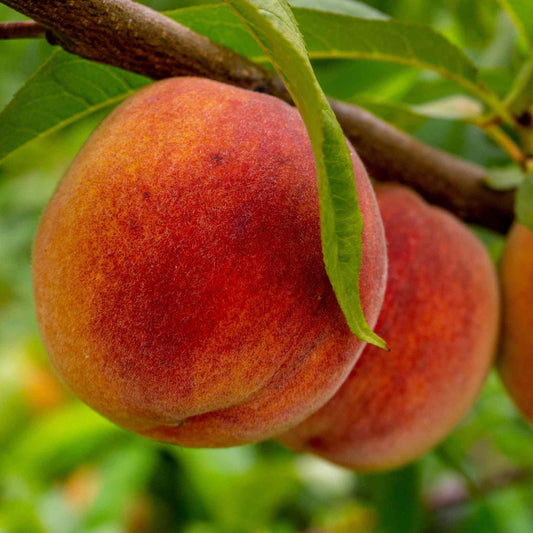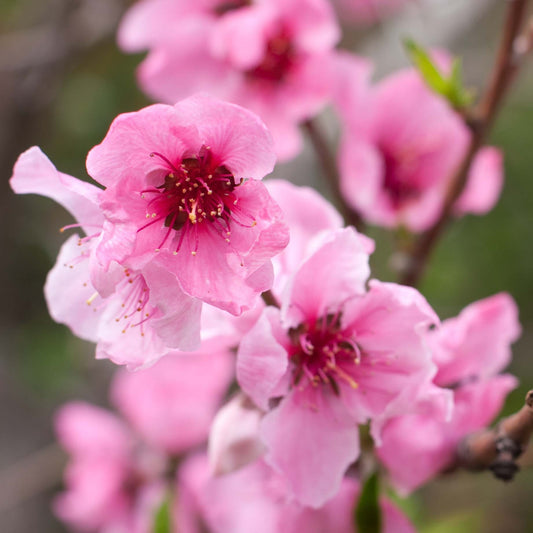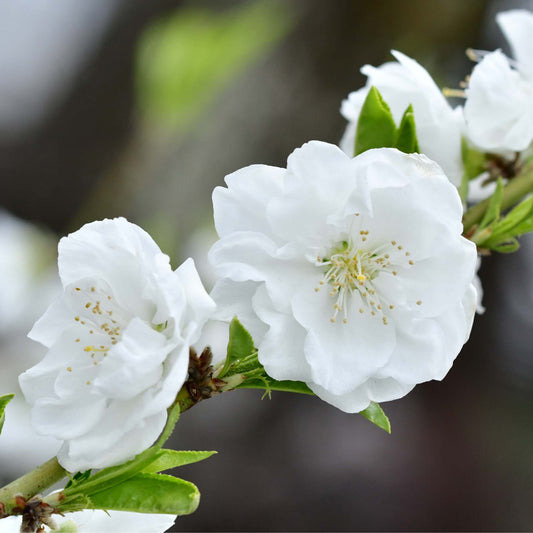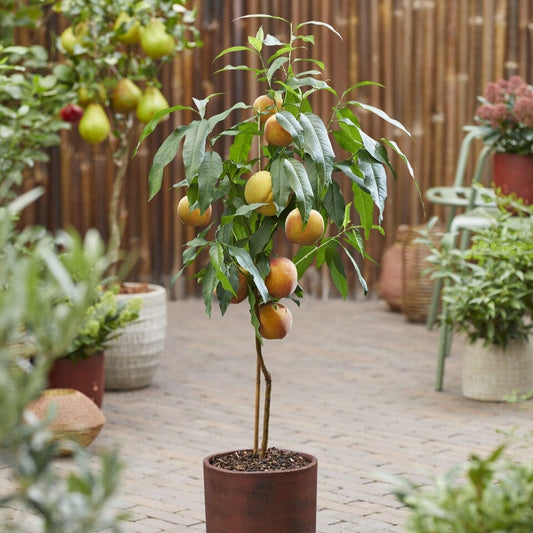Collection: Peach Trees
Nothing beats the flavour of a ripe peach fresh from the garden! Most peach and nectarine trees thrive in pots so you can grow your own sun-warmed stone fruits in even the smallest garden. Our growers choose premium varieties which are right for the UK climate, train them on quality rootstocks and professionally prune them before being sent out.
Need help picking?-
Regular price From £55Regular price Sale price From £55
'Avalon Pride' Peach Tree
A fantastic American variety
- Juicy, sweet and refreshing
- Resistant to leaf curl
- Make a tall glass of peach iced tea!
- Harvest in August
2 options available
-
Regular price From £40Regular price
£55Sale price From £40'Peregrine' Peach Tree
A hardy and reliable cropper
- Rich, luxurious flavour
- Freestone (flesh falls easily away)
- Create a peach and chilli chutney
- Harvest in August
2 options available
-
Regular price From £36Regular price
£50Sale price From £36'Lord Napier' Nectarine Tree
A fabulous heirloom variety
- Excellent levels of sweetness and juiciness
- First grown all the way back in 1860
- Prep a refreshing nectarine and burrata salad
- Harvest in August
1 option available
-
Regular price From £45Regular price Sale price From £45
'Red Haven' Peach Tree
Highly popular freestone peach
- Great flavour that leaves you wanting more
- Fruits feature a lovely red flush
- Bake some delicious peach streusel muffins
- Harvest from late July onwards
2 options available
-
Regular price From £65Regular price
£70Sale price From £65'Peche de Vigne' Bloody Peach Tree
An heirloom, red-fleshed peach
- Sweet peach flavour with a hint of raspberry
- An old variety with raspberry-red flesh!
- Peach melba? Yes, please!
- Harvest in August
1 option available
-
Regular price From £45Regular price
£50Sale price From £45'Rochester' Peach Tree
A reliable, golden-fleshed peach
- The kind of taste you dream about
- Blossoms appear late enough to miss frosts
- Why not give a scrummy peach semifreddo a go?
- Harvest from mid-August
1 option available
-
Regular price From £35Regular price Sale price From £35
'Madame Blanchette' Nectarine Tree
Heavy-cropping and oh-so tasty
- Sweet, decadent and moreish flavour
- Reliable even in colder areas
- Eat fresh or try in an upside-down cake!
- Harvest in August
1 option available
-
Regular price From £35Regular price
£45Sale price From £35'Inka' Peach Tree
A Polish powerhouse
- Sumptuously sweet, full-bodied flavour
- Great disease resistance
- Whip up a delicious peach cobbler
- Harvest from late August to September
2 options available
-
Regular price From £40Regular price
£50Sale price From £40'Flat' Nectarine Tree
Red-skinned 'donut' nectarines
- Wonderfully sweet and juicy
- Distinctive flat shape
- Make a nectarine clafoutis
- Harvest in mid-August
1 option available
-
Regular price From £38Regular price
£50Sale price From £38'Duke of York' Peach Tree
Melt-in-the-mouth peaches
- Excellent peach flavour with juicy sweetness
- An heirloom variety over 100 years old
- Makes a delicious German peach kuchen
- Harvest mid to late July
1 option available
-
Regular price £90Regular price Sale price £90
Patio Peach Tree | Prunus persica 'Pink Peachy'
Incredible pink blossoms
- Peaches with incredible sweetness
- Ideal for patios and balconies
- Whip up a scrummy peach cobbler
- Harvest from August to September
1 option available
-
Regular price £65Regular price Sale price £65
'Avalon Pride' Patio Peach Tree
Peaches from your doorstep!
- Deliciously juicy fruit
- Compact enough for small spaces
- Enjoy fresh with cream or baked in a pie
- Harvest from August
1 option available
-
Regular price From £30Regular price
£45Sale price From £30'Red Gold' Nectarine Tree
Perfect for a hot summer's day
- A wonderful mixture of sweet and tart
- Low-maintenance and easy to grow
- Caramelise and serve with vanilla ice cream
- Harvest in August
1 option available
-
Regular price From £35Regular price Sale price From £35
'Flavortop' Nectarine Tree
Flavour by name and nature!
- Charming bushy tree
- Medium tree - grows up to 5m
- Bake with almonds and Marsala
- Harvest from August to September
2 options available
-
Regular price £65Regular price
£70Sale price £65'Taoflora Red' Peach Tree
Punchy red hues in *two* seasons
- Picture-perfect bushy tree
- Medium tree - grows up to 4m
- Scented red double blooms, fiery autumn hues
- Responds well to pruning and shaping
1 option available
-
Regular price £65Regular price
£70Sale price £65'Taoflora Pink' Peach Tree
Beautiful pink flower clouds
- Showstopping bushy tree
- Medium tree - grows up to 4m
- Fluffy double pink blossoms up to 5cm across
- More disease resistant than other peaches
1 option available
-
Regular price £80Regular price Sale price £80
Patio Peach Tree | Prunus persica 'Red Peachy'
Beautiful balcony blossoms
- Sweet peaches with good juiciness
- Perfect for growing on the terrace
- Eat fresh from the tree!
- Harvest from August to September
1 option available
-
Regular price £65Regular price
£70Sale price £65'Taoflora White' Peach Tree
Snowy blooms heralding spring
- Perfectly-proportioned bushy tree
- Medium tree - grows up to 4m
- Voluminous double white blooms
- Hardy down to -18°C
1 option available
-
Regular price From £40Regular price
£42Sale price From £40'Saturne' Peach Tree
The original donut peach
- Floral flavour with a honeyed sweetness
- Highly-unusual flattened peaches
- Try your hand at a traditional peach cobbler
- Harvest from late August into September
Currently out of stock
-
Regular price £65Regular price Sale price £65
Patio Peach Tree | Prunus persica 'White Peachy'
Showers of snowy white blossoms
- The perfect level of sweetness
- Compact enough for patios and balconies
- Serve fresh with cream and sugar
- Pick from August to September
Currently out of stock
-
Regular price £50Regular price Sale price £50
'Melred' Red-Flowered Patio Peach Tree
Glorious hot-pink blossoms
- Divine fruits with punchy peach flavour
- Gorgeous pink blossom in spring
- Delicious eaten fresh from the tree
- Harvest your peaches in August
Currently out of stock
Roots' Cotswolds Valley Nursery
Meet Mike
Tree-growing skills honed right across the globe
Having started out in Australia, studied in Northern Ireland and volunteered at an organic farm in Sweden, it’s fair to say Mike’s done his fair share of travel on his horticultural journey, so far! Having happily laid down roots here at Roots, Mike is the don behind our tree-growing operation, imparting each and every one of his globally-honed skills to benefit your garden. Grown in our purpose-built nursery, in the ideal climatic conditions of the fertile Vale of Evesham, we’re proud to supply only the happiest, healthiest and hardiest trees.
Need help picking?

Which peach tree should you choose?
All of our peach trees are self-fertile and hardy in the UK. The most popular, 'Peregrine' and 'Avalon Pride', are reliable croppers, full of flavour and come in a variety of sizes to suit any garden. For growing in patio pots, nectarines like 'Lord Napier' or 'Madame Blanchett' (also self-fertile) are ideal. Heavy-cropping peach tree 'Red Haven' is a great choice for medium or large gardens. Find out which peach is perfect for your garden.

What's the deal with peach tree rootstocks?
A peach tree’s eventual size depends on which rootstock it’s grown on, so it’s an important thing to know. A tree on Montclare rootstock will reach a compact height of around 3m unless pruned smaller, whereas peaches and nectarines on St Julien A (SJA) are more vigorous at around 4m.

Growers' tips for peach trees
Peaches and nectarines need lots of sun, so if you’re planting in the ground, make sure you position them in a warm, sheltered spot (ideally trained against a south or west-facing wall). For growing peach trees in pots, choose a sunny, sheltered position on a patio and bring the pots indoors during the colder months. Peaches and nectarines can even be grown in a greenhouse or conservatory. They tolerate most soils, but you can aid drainage by adding some pea gravel to the hole when you plant them. In pots, make sure the compost never dries out. Peaches are ready to be harvested when they come away from the branch with a gentle twist.

Using your peaches
Say ‘peach’ and it’s the classic dessert created for Dame Nellie Melba that comes to mind, with juicy peaches tempered by the sweeter and more mellow raspberry. This easy pavlova traybake brings the flavours right up to date. Baked, caramelised, poached or roasted, peaches are a gourmet treat, but nothing beats biting into a fresh one straight off the tree and feeling the juice run down your chin!
Peach Trees FAQs
Can I grow peach trees in the UK climate?
Although peaches originate from sunnier climes, thanks to new, hardier varieties being bred, it’s now possible to grow peaches successfully in the UK. Our growers have put together a guide to choosing the best peach tree for your area.
When is the best time to plant peach trees in the UK?
Bare root peach trees should be planted between November and April, when they’re in their dormant phase. Potted peach trees can be planted at any time of year, as long as the ground isn’t waterlogged or frozen over. Early spring is the best time, as this allows the tree to establish a good root system before the growing season.
Where should I plant peach trees?
Peach trees do best in a sunny, sheltered spot with well-drained soil. South-facing walls or fences are a good place to plant, as they can provide extra warmth and protection from cold winds. Patio peach trees can also be planted in pots and grown outdoors or in a conservatory or greenhouse.
How much space do peach trees need?
Full size peach trees should be planted about 4-6m apart to allow for good air circulation and so they can spread out to their mature size. Patio varieties will vary - check on the individual variety page before choosing yours.
Do peach trees need special soil?
Not especially; they prefer slightly acidic to neutral soil with good drainage. If your soil is heavy clay or alkaline, you can improve it by mixing in lots of compost or well-rotted manure.
How often should I water peach trees?
Water your peach tree regularly when it’s newly planted, and especially during dry spells. Once it’s established (after a year or two), water it deeply once a week during the growing season, but avoid overwatering, and stop altogether during autumn and winter.
Do peach trees need to be fertilised?
Peach trees will flower and fruit best with a bit of fertiliser. Apply a fruit tree fertiliser or general purpose plant food in early spring, before the blossom starts to appear.
How do I protect peach trees from frost?
Peach trees need to be protected from late spring frosts, which can damage the blossoms and result in a smaller crop. You can bring potted trees indoors, or wrap trees in the ground with horticultural fleece or bubble wrap.
How do I prune peach trees?
Prune your peach tree in late winter or early spring before the new growth starts. Remove any dead or diseased wood, thin out crowded or crossing branches and give it a light trim if necessary, to keep it well-shaped and fitting its space.
When can I expect to harvest peaches?
Peach trees usually take around two years to produce fruit. Harvest times vary according to the variety and local conditions, but peach trees can fruit at any time from late summer to early autumn. Pick your peaches when they’re fully ripe and give slightly when squeezed.
Can I grow peach trees in containers?
There are lots of great patio sized peach trees which are great for containers. Choose a large pot with good drainage holes and fill it with high-quality compost. Position your pot in a sunny place, feed and water it regularly and prune it yearly to keep it to the size you want it.
Happy plants make happy customers

Plants arrived in great condition and very promptly. Well established - much better than the ones I got at my local garden centre.
Monica Spence
| 24 May
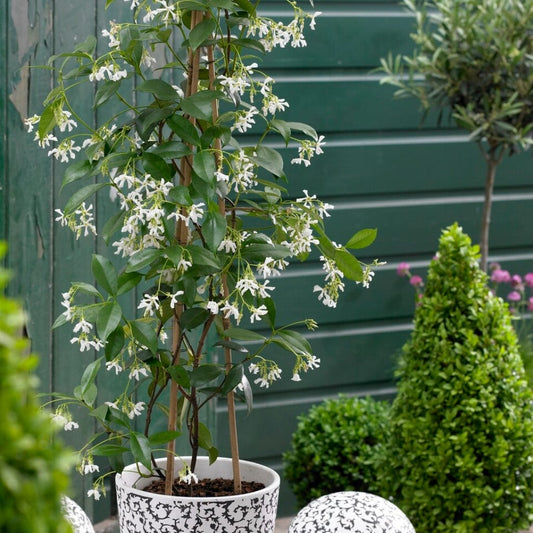
Yet again this company delivered good healthy plants, exactly as shown in photos, well packaged and within delivery time quoted. Recommend!
Jacqueline Burgess
| 2 Jun

I continue to be so impressed with Roots. Their customer care, knowledge of their subject: from planting hedges to pruning roses and more, has been a great support.
Judy Lane
| 23 Oct

The plant arrived looking vigorously healthy, which brings a smile to your face, extremely well protected in its packaging.
Martyn Hill
| 5 Jul

As a non-gardener, I found my whole experience brilliant. Great information & advice available on the website, great range of products & prices are brilliant.
John-Paul
| 22 May

Wonderful plants and great customer service... really surprised to find that the plants are better than those you would get at your local garden centre.
Gavin Wilcock
| 8 Nov
Fighting plastic waste
Delivering fresh from the nursery
Supporting UK growers













